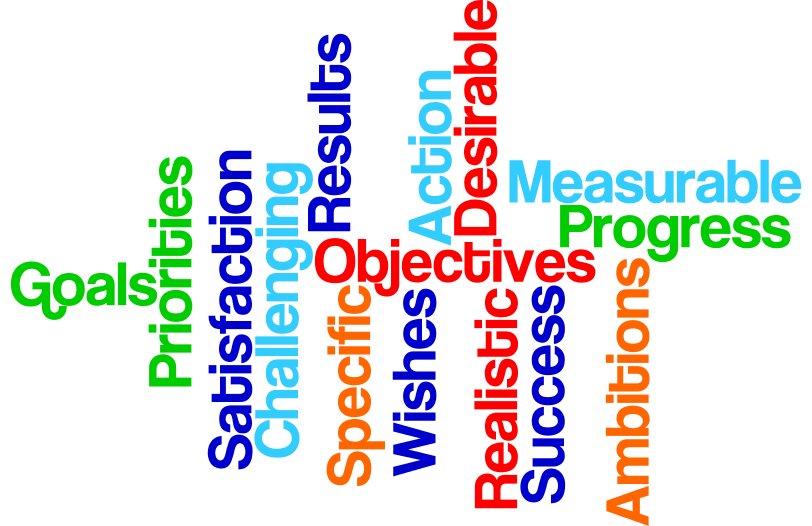The New Year is when many of us step back, take a good look at our lives and careers, and resolve to change things for the better. We make a list of wishes and pledge that this year will be different than the previous. "This year I’ll… improve my work-life balance, take on more responsibilities, get a raise, be more organized, acquire a new skill…”. But then "Fail Friday" (the third Friday of the month, when our willpower is most likely to fade) comes along and we already start re-framing those resolutions... they become casual promises. By March they turn into wishful thinking, April sets in and you are simply daydreaming …and this year starts looking a lot like last year. And you are not the only one - Research shows that only 8% of people achieve their objectives (Source: University of Scranton (2014) "New Year Resolution Statistics" Journal of Clinical Psychology).
Objective setting is a concept filled with potential. Top-level athletes, successful business-people and achievers in all fields all set objectives. Objective setting not only allows you to take control of your life's direction; it also provides you a benchmark for determining whether you are actually succeeding. It’s not just a wish list; it’s a process that allows you to create recipes for success!
Objective setting starts with careful consideration of what you want to accomplish, and ends with investing your energies to actually achieving it. In between, there are well defined steps that will allow you to formulate objectives that you can accomplish.
An objective is not the work performed, but the results expected once the work is done. If you are serious about achieving your objectives, get the tools you need to make this the year your ambitions go beyond mere possibilities and turn into tangible results. The following guidelines will help you set effective objectives:
Set objectives in writing - Did you know that less than 3 percent of people have written objectives, and of those who do less than 1 percent review and rewrite their objectives on a regular basis? Unless an objective is written, it is merely an aspiration. Once you commit it to writing, you set something in motion. You clarify what you want and begin focusing on how to attain it. The physical act of writing down an objective makes it real and tangible. This crystallizes it and gives it more force.
Set positive objectives - State each objective as a positive statement. How you think about your objective can influence how you feel about it, and whether or not you achieve it. Negative objectives are emotionally unattractive, which makes it hard to focus on them. Reframe any negative objectives so that they sound positive: you may be surprised by the difference this makes! Shawn Achor, author of The Happiness Advantage says “When the human brain is positive, our intelligence rises, we stop diverting resources to think about anxiety. Our creativity triples. Productive energy rises by 31 per cent. The likelihood of promotion rises by 40 percent."
Be precise - Your objective must be clear and well defined. Vague or generalized objectives are unhelpful because they don't provide sufficient direction. Remember, you need objectives to show you the way and they should be detailed enough so that you understand well what needs to be accomplished. Make it as easy as you can to get where you want to go by defining precisely where you want to end up.
Make them measurable - The only way to know if you have achieved an objective is to quantify it. Include precise amounts, due dates, times and percentages so you can measure your degree of success. To determine if your objective is measurable ask yourself the following questions: How many? How much? For when? How will I know that my objective is achieved? Without a way to measure your success you miss out on the celebration that comes with knowing you have actually achieved it.
Set desirable objectives - Set objectives that motivate you. Motivation is key to achieving objectives. Society, family, friends, employers may want to influence the objectives you set. Objectives should be personally compelling, in line with your own desires and ambitions, and relevant to the direction you want to take. Write down a set of motivations identifying why it is important to you and what is at stake. This step is significant, because studies have indicated that people are more likely to succeed in changing their behavior when they are motivated by internal rather than external forces. By keeping objectives aligned with your desires, you develop the focus and the drive you need to get ahead and do what you want.
Stretch out of your comfort zone - An objective should be challenging but should not discourage you before you even start. An objective can be ambitious and realistic at the same time; only you can decide the level of accessibility to your objective. Make sure each objective represents substantial growth. Safe objectives are boring objectives. Resist the urge to set objectives that are too easy, it will not contribute to your confidence and will stump your satisfaction. By setting realistic yet challenging objectives, you hit the balance you need. Set objectives that require you to "raise the bar" and bring personal satisfaction.
Set priorities - An old Chinese proverb says, “Man who chases two rabbits catches neither.” While you probably need more than a single objective, you need to stay focused on a manageable number of them. When you have several objectives, give each a priority. This helps you to avoid feeling overwhelmed by having too many objectives, and helps to direct your attention to the most important ones. Use the "quality, not quantity" rule when setting objectives.
Elaborate an action plan - This step is often missed in the process of objective setting. You get so focused on the outcome that you forget to plan all of the steps that are needed along the way. By writing out the individual steps you can initiate and maintain momentum, especially if your objective is big and demanding, or long-term. Build in reminders to keep yourself on track, and make regular time-slots available to review your plan.
Estimate realistic completion time - How often has a task or project taken longer than you thought? If you don't estimate objective completion time accurately, all your planning will falter and it may cause you to give up. Always pad your timelines to account for novelty, delays and setbacks.
Keep them visible - Post your objectives in visible places to remind yourself every day of what it is you intend to do. Put them on your walls, calendar, desk, computer monitor, bathroom mirror or refrigerator as a constant reminder.
Review your progress - It takes time to accomplish objectives. And sometimes it can feel like you aren't making much progress. Take stock of everything that you've accomplished on a regular basis and measure your progress. Not only will progress motivate you to continue towards your objective, it will also give you the opportunity to analyze what you need to do to keep moving forward.
Appreciate failure – Sometimes, no matter how hard you work, you will fail to achieve your objectives. However, failure contains lessons if you have the courage and wisdom to learn from it. Each time we encounter failure, we learn about ourselves and what we have to overcome. Failing to achieve your objectives doesn’t mean that you failed but that your plan failed. So don't be distressed – just take note of where you went wrong and feed that knowledge back into the process of setting your next objectives.
Living a life without setting objectives is like sailing a ship with no destination: you may end up somewhere that you didn't want to go! This is why setting objectives is so important to achieve your dreams, ambitions and personal success.
So, what objectives have you decided to accomplish this year?











